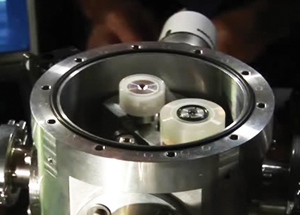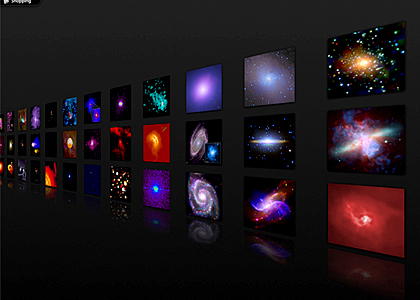Submitted by chandra on Tue, 2009-01-13 01:06
While we like the written word as much as the next person, we thought it would be good to mix things up. We recently got a new, small, handheld video camera (about the size of a cell phone). The plan is to use this to add simple videos to the Chandra blog and other places on the website. Because it's handheld and very sensitive, it's easy for the videos to appear shaky and the sound is not perfect. We'll work on this for the future.
Submitted by chandra on Tue, 2009-01-06 14:16
There are some exciting, yet different, Chandra-related events happening at the American Astronomical Society (http://aas.org/) meeting in Long Beach, CA today. First, there was a press conference this morning to announce new results on Cassiopeia A that bring this supernova remnant "to life". One result shows how Cas A has changed from 2000 – just after Chandra’s launch – through until late 2007. This is the first time scientists have been able to watch as a supernova remnant changes like this over time.
Submitted by chandra on Mon, 2008-12-22 11:29
It sounds like a good portion of the United States got walloped over the weekend with snow and ice and seemingly everything in between. (Yesterday was, after all, the winter solstice and the official start of the season, so what else should we have expected?) While the white stuff can be beautiful, it can also put a damper on holiday errands. For those of us who might be lagging behind on getting their holiday cards in the mail, we here at Chandra can help you out.
Submitted by chandra on Wed, 2008-12-17 11:52
By now, you've probably seen the news stories on our exciting and important new work on dark energy. For those of you who want even more, take a look at this posting on YouTube. The main scientist behind these results, Alexey Vikhlinin of the Smithsonian Astrophysical Observatory, put together a great movie describing the new science.
Watch the video on Youtube
Submitted by chandra on Thu, 2008-12-04 11:39
There are those of us who are experts, and then those of us who are not. Even some of us who have been working in X-ray astronomy can lose track of some of the basics. To help provide a little introduction or perhaps just a refresher, we’ve put together a little thing we like to call “X-ray 101â€. It’s meant just to give a very quick overview of what Chandra is and what X-ray astronomy is all about.

A sample image from the activity
Submitted by chandra on Mon, 2008-11-24 14:38
Recently a group of researchers from the University of California at Los Angeles announced what has been described by the New York Times as a "tour de force of office supply physics." The scientists measured X-ray flashes from a roll of Scotch tape as it was unpeeled.

Watch the full video at Nature
Submitted by chandra on Wed, 2008-11-19 10:48
Now that we shamelessly have your attention, we'd like to invite you to take a survey about our newly redesigned website. We know, we know, surveys can be less than stimulating. To make it worth your while, we are offering the possibility of a free package of Chandra goodies – bookmarks, postcards, etc. – that will be mailed directly to you. We’ll pick 50 people randomly to get the stuff, and we’ll let you know if you’ve been chosen.
Submitted by chandra on Mon, 2008-11-17 13:38
While we like to focus on the current excitement in X-ray astronomy, sometimes it's good to look back. Last week marked the 30th anniversary of the launch of the Einstein Observatory. Back on November 13, 1978, the High Energy Astrophysics Observatory 2 was launched on Atlas-Centaur booster rocket. Shortly afterward, the satellite was renamed in honor of that little known scientist, Albert Einstein. While HEAO-2 is catchy, we think Einstein is a little easier off the tongue.
Submitted by chandra on Thu, 2008-11-06 12:04
If you haven't noticed by now, we like new things around here. In fact, it almost pains us to see something out there that's fun and exciting that we’re not a part of. So to remedy that, we just try to get Chandra involved with everything we can. The latest, in our humble opinion, is very cool.

Submitted by chandra on Tue, 2008-10-28 13:53
As many of this blog's readers may know, Chandra is NASA's flagship X-ray mission but it's not the only major X-ray telescope in orbit. The other one is XMM-Newton, which was launched by the European Space Agency (ESA) just five months after Chandra in 1999. The great thing about Chandra and XMM-Newton is that many of their capabilities are complementary. In other words, scientists often use both and can combine the data for even stronger results.
Pages